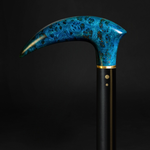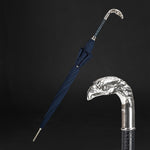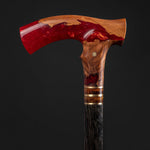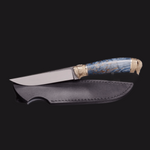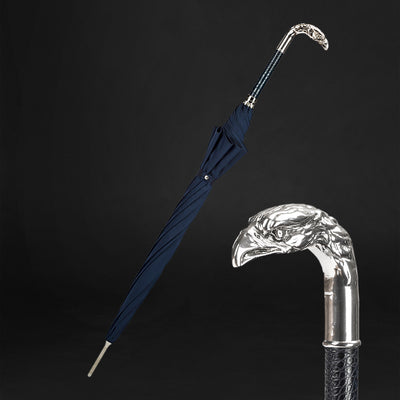You have no items in your shopping cart.
Recent Posts
-
Why an Elegant Cane Is a Thoughtful Gift for Loved Ones?
-
The Art of Christmas Design: Walking Canes That Celebrate the Season in Style
-
How an Ergonomic Walking Cane Handle Prevents Hand and Wrist Strain?
-
How to Walk With a Cane Correctly to Avoid Back or Shoulder Strain?
-
5 Common Mistakes People Make When Buying a Walking Cane (and How to Avoid Them)
-
How to Choose a Walking Cane That Reflects Your Personality (Not Just Your Needs)?
MOST POPULAR NOW
01
Apr
Walking sticks have been used for centuries as a way to aid in mobility, and for good reason. They provide a sense of stability and support, making walking a safer and more enjoyable experience. In this article, we'll be discussing the definition of walking sticks, their purpose, why proper use is important, and who can benefit from using them.
How to use your walking stick properly: tips and tricks for beginners?
Definition of walking stick
A walking stick, also known as a cane, is a long, sturdy stick that is used to aid in walking. They come in a variety of shapes, sizes, and materials, such as wood, metal, or plastic. Walking sticks can have a single point or multiple points of contact with the ground, depending on the design.

Purpose of walking sticks
The primary purpose of a walking stick is to provide support and stability while walking. They can help distribute weight more evenly across the body, reducing the strain on the legs and feet. Walking sticks also help to maintain balance, which is especially important for people with mobility issues, such as the elderly or those with disabilities.
Walking sticks can also be used as a fashion accessory or status symbol. In some cultures, ornate and highly decorated walking sticks were a sign of wealth and power. In modern times, walking sticks can be customized with various designs or colors to reflect the user's personal style.
Why proper use is important?
While walking sticks can be incredibly helpful, it's important to use them properly to avoid injury. The stick should be held in the hand opposite the injured or weaker leg, and should be positioned so that the top of the stick reaches the user's hipbone. The user should avoid leaning on the stick too heavily, as this can cause pain or discomfort in the hand, wrist, or elbow.
It's also important to choose the right type of walking stick for your needs. If you're using the stick for support, you'll want to choose one that's sturdy and durable. If you're using the stick for fashion purposes, you'll want to choose one that's lightweight and easy to carry.
Who can benefit from using a walking stick?
Walking sticks can benefit a wide range of people, including the elderly, those with mobility issues, and those recovering from an injury or surgery. They can also be helpful for people who spend a lot of time on their feet, such as hikers or outdoor enthusiasts.
Walking sticks can provide a sense of independence and freedom, allowing users to move around with confidence and ease. They can also help to reduce the risk of falls and injuries, which is especially important for older adults or those with balance issues.
In conclusion, walking sticks are a valuable tool for anyone who wants to improve their mobility and quality of life. Whether you're using them for support, fashion, or both, it's important to choose the right type of walking stick and use it properly to avoid injury. If you're considering using a walking stick, talk to your doctor or physical therapist to find out which type is best for your needs.
Getting started
Walking is a great exercise that has numerous benefits for the body and mind. A walking stick can be a valuable accessory that helps you maintain balance and reduce the strain on your joints while walking. However, choosing the right walking stick can be a daunting task, especially if you are new to walking with a stick. In this article, we will guide you through the process of choosing the right walking stick that suits your needs.
Proper length and height
The first thing you need to consider when choosing a walking stick is the length and height of the stick. The length of the stick should be determined by your height. The stick should be long enough to support your weight and provide balance while walking. The ideal height of the stick should be at the level of your wrist when your arm is hanging straight down by your side. This ensures that you can maintain an upright posture while walking and reduce the strain on your joints.
Selecting the right handle
The handle of the walking stick is another important factor to consider when making your selection. The handle should be comfortable to hold and provide a firm grip. There are different types of handles available, each with its own unique benefits.
The most common type of handle is the crook handle, which provides a comfortable grip and can be hung over your arm when not in use. Another popular type of handle is the derby handle, which is ergonomic and provides excellent support for your wrist. The fritz handle is also a good option, as it provides a comfortable grip and is suitable for individuals with arthritis or other hand conditions.
Types of walking sticks
There are different types of walking sticks available, each with its own unique features and benefits. The most common type is the wooden walking stick, which is sturdy and provides excellent support. However, wooden walking sticks can be heavy and may not be suitable for individuals who have difficulty lifting heavy objects.
Aluminum walking sticks are lightweight and durable, making them ideal for individuals who are looking for a stick that is easy to carry and provides good support. Carbon fiber walking sticks are another good option, as they are lightweight and strong, making them suitable for individuals who are looking for a high-performance walking stick.
In addition to traditional walking sticks, there are also hiking sticks and trekking poles available, which are designed for more rugged terrain. These sticks are usually adjustable in length and come with shock-absorbing features, making them suitable for individuals who are looking for a stick that can withstand more rigorous activities.
Choosing the right walking stick is essential to ensure that you get the maximum benefits while walking. By considering factors such as the length and height of the stick, the type of handle, and the type of stick, you can select a walking stick that suits your needs and provides the support you require.

Techniques for using a walking stick
walking stick can be an invaluable tool for individuals who need support while walking. However, using a walking stick requires proper techniques to ensure that you get the maximum benefits while reducing the risk of injury. In this article, we will guide you through the techniques for using a walking stick.
Proper posture and positioning
The first thing to consider when using a walking stick is your posture and positioning. Your back should be straight, and your head should be held up. Your arms should be relaxed and should hang naturally at your sides. When using a walking stick, your weight should be evenly distributed between your legs, and your shoulders should be level.
How to hold a walking stick?
To hold a walking stick, place the handle of the stick in the palm of your hand, and wrap your fingers around the handle. Your thumb should be placed on top of the handle, and your fingers should grip the underside of the handle. Make sure that you have a comfortable grip on the handle to avoid slipping.
Correct placement of a walking stick
The correct placement of a walking stick is essential to ensure that you get the maximum benefits while walking. The stick should be placed on the opposite side of your injured or weaker leg. For example, if you have a weak right leg, you should place the walking stick on your left side. This helps to provide balance and support while walking.
How to walk with a walking stick?
When walking with a walking stick, take small steps and keep your weight evenly distributed between your legs. Place the walking stick a few inches in front of your weaker leg, and then step forward with your stronger leg. As you step forward, lean slightly on the walking stick for support. Repeat this process with each step.
Techniques for going up and down stairs
When going up and down stairs, hold the walking stick in your opposite hand and use the handrail for support. Step up with your stronger leg first, and then bring your weaker leg up to the same step. When going down the stairs, step down with your weaker leg first, and then bring your stronger leg down to the same step.
Walking on different terrains
Walking on different terrains can be challenging, but with the right technique, you can make it easier. When walking on uneven terrain, place the walking stick on the ground first to test the stability of the terrain. Take small steps and keep your weight evenly distributed between your legs. When walking on slippery terrain, use the walking stick for support and take small, careful steps.
Using a walking stick requires proper techniques to ensure that you get the maximum benefits while reducing the risk of injury. By considering factors such as proper posture and positioning, how to hold a walking stick, the correct placement of a walking stick, how to walk with a walking stick, techniques for going up and down stairs, and walking on different terrains, you can use a walking stick effectively and safely.
Tips and tricks
When it comes to walking aids, walking sticks are a popular choice for people who want a reliable and sturdy support for their daily walks or hikes. However, with so many options available on the market, it can be overwhelming to choose the right walking stick that suits your needs. In this article, we'll guide you through the process of choosing the right walking stick by discussing the proper length and height, selecting the right handle, and the types of walking sticks available.
Proper length and height
The proper length and height of your walking stick is crucial for your comfort and stability. The ideal length of your walking stick depends on your height, arm length, and the type of terrain you'll be walking on. A good rule of thumb is to have your elbow bent at a 15-degree angle when holding the stick in a relaxed position. This ensures that the walking stick is at the correct height for your arm length.
To measure the correct length, stand up straight with your arms at your side and measure the distance from your wrist to the floor. This is the approximate length of your walking stick. It's essential to adjust the length of your walking stick to suit different types of terrain to maintain balance and stability.
Selecting the right handle
Walking sticks come in different types of handles, each with its advantages and disadvantages. The most common types of handles are the Derby, Fritz, and Crook handles. Derby handles are the most versatile and offer a comfortable grip for people with arthritis or other hand conditions. Fritz handles are ergonomic and fit the shape of your hand, reducing hand fatigue during long walks. Crook handles are suitable for people with wrist or hand problems and provide a secure grip when walking.
Types of walking sticks
Walking sticks are available in various materials, including wood, metal, and carbon fiber. The type of material you choose depends on your needs and preferences. Wooden walking sticks are traditional and offer a classic look, but they can be heavy and prone to breaking. Metal walking sticks are lightweight and durable, but they can be expensive. Carbon fiber walking sticks are the lightest and most durable but are also the most expensive.
Techniques for using a walking stick
Using a walking stick correctly can help improve balance, mobility, and overall stability. Here are some tips on how to use a walking stick effectively:
Proper posture and positioning - Stand up straight and hold the walking stick close to your body, with your elbow slightly bent.
How to hold a walking stick - Hold the walking stick with your dominant hand at the same height as your hip bone. Your other hand should be relaxed at your side.
Correct placement of a walking stick - Place the walking stick on the opposite side of your injured or weak leg, ensuring that it's secure before taking a step.
How to walk with a walking stick - Take small steps and keep your eyes on the path ahead. The walking stick should always be in contact with the ground.
Techniques for going up and down stairs - When going up stairs, hold the walking stick in the opposite hand and step up with your stronger leg first. When going down stairs, place the walking stick on the lower step first and step down with your weaker leg first.
Walking on different terrains - When walking on uneven terrain, use the walking stick to feel for any obstacles or hazards. When walking on slippery or wet surfaces, use the walking stick for added stability.
Conclusion
In conclusion, using a walking stick can greatly improve mobility and balance for those who need it. By choosing the right walking stick, properly adjusting it to the correct height and handle, and practicing the proper techniques for use, individuals can greatly benefit from the support provided by a walking stick.
When using a walking stick, it is important to remember to maintain good posture and positioning, properly hold the walking stick, and walk with a natural gait. Going up and down stairs and walking on different terrains also requires special techniques.
For those who are new to using a walking stick, it may take time to adjust and build up the necessary strength and balance. However, there are exercises that can be done to improve balance and mobility. Additionally, taking care of the walking stick through proper maintenance and using accessories can help prolong its lifespan.
Lastly, it is important to avoid common mistakes such as relying too heavily on the walking stick and not practicing proper techniques. With practice and patience, individuals can fully benefit from using a walking stick.
Summary of key points:
- Choosing the right walking stick based on height, handle, and material
- Proper posture and positioning when using a walking stick
- Techniques for holding and walking with a walking stick
- Techniques for going up and down stairs and walking on different terrains
- Exercises to improve balance and mobility
- Maintenance and care of your walking stick
- Accessories for walking sticks
- Common mistakes to avoid
Benefits of using a walking stick:
- Improved mobility and balance
- Increased independence and confidence
- Reduced risk of falls and injuries
We encourage individuals who may benefit from using a walking stick to give it a try and practice patience as they adjust to its use. With the right techniques and care, a walking stick can greatly improve one's quality of life.
Also Purchased
-
Beige Walking Cane for Ladies Chamomile Flower, Wooden Walking Stick
Introducing our beautiful Beige Walking Cane for Ladies with Chamomile Flower, a Wooden Walking Stick that is hand carved and handmade, making it both pretty and unique. This walking cane...$79.50 -
Black Skull Head Walking Stick, Wedding Ceremony Designer Skull
Looking for a stylish and unique walking stick to elevate your look at your next event? Check out our Black Skull Head Walking Stick, the perfect accessory for any wedding...From $217.00 -
Exotic Burl Wood Walking Cane – Fashionable Artisan Stick
A sculptural statement in deep, oceanic blue — this walking cane is more than a support accessory, it's wearable art. Meticulously hand-shaped from stabilized burl wood, the handle evokes the...$425.00 -
ArtWalkingSticks™ MAGIC Walking Cane, Handmade - Make to Order
This piece of art is created for those who value details. We make one of a kind, handcrafted wood and resin canes. Our Wooden Canes are completely unmatched in creativity....$430.00 -
Umbrella with Eagle Handle, Fashion Umbrella For Men
Make a bold and fashionable statement with our Umbrella with Eagle Handle - a unique and functional accessory designed for men. The striking eagle handle is the highlight of this...$325.00 -
Fashionable Lion Shoehorn Long Handle, Pearly Brown Shaft, Handmade
Introducing our Fashionable Lion Shoehorn, a handcrafted, long-handled shoe horn with a pearly brown shaft that's both stylish and practical. The intricate Lion design adds a touch of elegance to...$240.00
















